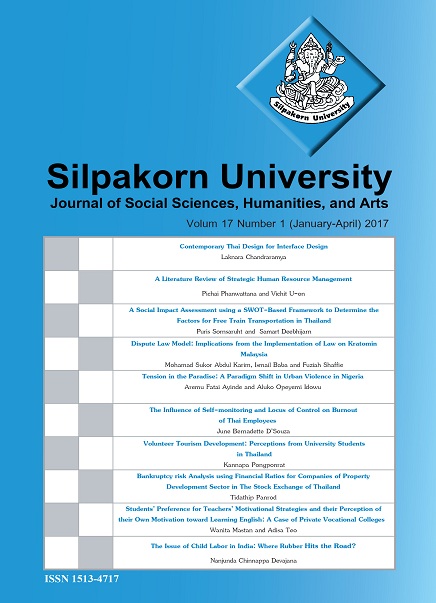Students’ Preference for Teachers’ Motivational Strategies and their Perception of their Own Motivation toward Learning English: A Case of Private Vocational Colleges
Main Article Content
Abstract
This study aimed to investigate students’ preference for teachers’ motivational strategies, their perception of their own motivation toward learning English in relation to teachers’ motivational strategies, and the correlation between these two variables. The participants consisted of 320 first year vocational certificate students in the 7 private vocational colleges. A questionnaire and semi-structured interview were employed in data collection. The 24 motivational strategy items were categorized into four main categories based on Dörnyei’s (2001b) framework. Descriptive statistics and Pearson's correlation coefficient were used to analyze the data. The findings indicated that 22 teachers’ motivational strategies were preferred at the “greatly preferred” level, whereas only two strategies were preferred at the “preferred” level. It was found that all 24 motivational strategies could motivate students to learn English. The students most preferred motivational strategies under the third category, maintaining and protecting students’ motivation. They also agreed that the motivational strategies under the third category could motivate them to learn the most. On the other hand, the strategies under the fourth category, encouraging positive self-evaluation, were least preferred and they least motivated the students to learn English. Interestingly, it was found that all preferred strategies could motivate the students to learn English.
Downloads
Article Details
All rights reserved. Apart from citations for the purposes of research, private study, or criticism and review,no part of this publication may be reproduced, stored or transmitted in any other form without prior written permission by the publisher.
References
Alrabai, F. (2014) Motivational Practices in English as a Foreign Language Classes in Saudi Arabia: Teachers Beliefs and Learners Perceptions. Arab World English Journal 5: 224-246.
Bernaus, M., Wilson, A. and Gardner, R. C. (2009) Teachers’ Motivation, Classroom Strategy Use, Students’ Motivation and Second Language Achievement. PortaLinguarum 12: 25-36.
Boonrangsri, K. (2004) The Attitude towards English Language Learning of the Students in Vocational Certificate Level under Curriculum In 2002, a Case Study of Ayutthaya Technical College. M. A. thesis, Naresuan University, Pitsaanuloak, Thailand.
Brown, H. D. (2000) Principles of language learning and teaching, 4th ed., New York: Longman.
Cho, E. Y. and Teo, A. (2013) EIL Teachers’ Motivational Strategies and Students’ Preference in the Deep Southern Part of Thailand. International Journal of English zanguage Education 2: 15-31.
Dörnyei, Z. (1994) Motivation and Motivating in the Foreign Language Classroom. The Modern Language Journal 78: 273-284.
Dörnyei, Z. (1998) Motivation in Second and Foreign Language Learning. Language Teaching 31: 117-135.
Dörnyei, Z. (2000) Motivation in Action: Toward a Process-oriented Conceptualization of Student Motivation. British Journal of Educational Psychology 70: 519- 538.
Dörnyei, Z. (2001a) Teaching and Researching Motivation. London: Longman.
Dörnyei, Z. (2001b) Motivational Strategies in the Language Classroom. Cambridge: Cambridge University Press.
Gardner, R. (1985) Social Psychology and Second Language Learning: The Role of Attitudes and Motivation. London: Edward Arnold.
Gorham, J. and Christophel, D. M. (1992) Students’ Perceptions of Teacher Behaviors as Motivating and Demotivating Factors In College Classes. Communication Quarterly 40: 239-252.
Guilloteaux, M. J. and Dörnyei, Z. (2008) Motivating Language Learners: A Classroom-oriented Investigation of the Effects of Motivational Strategies on Students’ Motivation. TESOL Quarterly 42: 55-77.
Hinkle, D. E., Wiersma, W. and Jurs, S. G. (2003) Applied Statistics for the Behavioral Sciences. 5th ed., Boston: Houghton Mifflin.
Kitjaroonchai, N. and Kitjaroonchai, T. (2012) Motivation toward English Language Learning of Thai Students Majoring in English at Asia-Pacific International University. Catalyst 7: 21-38.
Krejcie, R. V. and Morgan, D. W. (1970) Determining Sample Size for Research Activities. Educational and Psychological Measurement 30: 607-610.
Mastan, W. and Teo, A. (in press) Teachers’ Motivational Strategies: A Case of Private Vocational Colleges. Proceedings of the 8th International Conference on Humanities and Social Sciences, National Defence University of Malaysia, Selangor, Malaysia.
Oxford, R. L. and Shearin, J. (1994) Language Learning Motivation: Expanding the Theoretical Framework. The Modern Language Journal 78: 12 -28.
Papi, M. and Abdollahzadeh, E. (2011) Teacher Motivational Practice, Student Motivation, And Possible L2 selves: An examination in the Iranian EFL context. Language Learning 62(2): 571-594.
Scarcella, R. C. and Oxford, R. L. (1992) The Tapestry of Language Learning: The Individual in the Communicative Classroom. Boston: Heinle & Heinle Publishers.
The Office of Vocational Education Commission. (2008) OVEC Research Strategic Plan. Bangkok: SV. Graphics and printing.
Trang, T. T. T. and Baldauf, R. B. (2007) Demotivation: Understanding Resistance to English Language Learning- the Case of Vietnamese Students. The Journal of Asia TEFL 4(1): 79-105.


